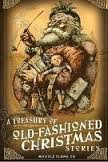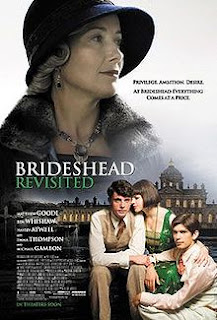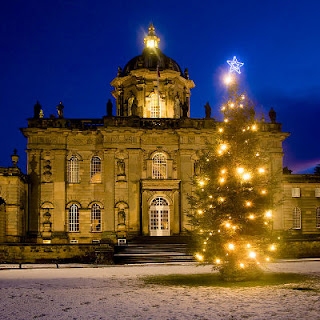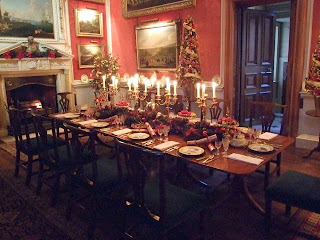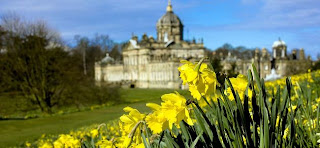That would be Victoria H. not Victoria R. — you’ve already heard about her Christmas.
My family always had an English Christmas dinner, complete with Roast Beef, Yorkshire Pudding and for dessert, Plum Pudding made by my grandmother, known as Mimi, from a recipe suposedly brought to the U.S. by her grandmother (my great-great grandmother) Elizabeth Stanley about 1850.
Elizabeth and Thomas Stanley came by ship from Liverpool to New Orleans and up the Mississippi to St. Louis. They traveled east across Illinois almost to the border with Indiana, the Wabash River.
There, in the little town of Albion, Illinois, they settled. They had come from their home in Yorkshire with eight children including a pair of 2-yr.-old twins. I can’t begin to imagine what they endured. A final son was born to them in 1852, named George Washington Stanley, my great-grandfther. He became the sheriff of Edwards County, IL, of which Albion was the seat. So Mimi (1890-1975) spent a part of her childhood in a house on Court House Square which also held the office and jail as well as the residence of the county’s leading law enforcer.
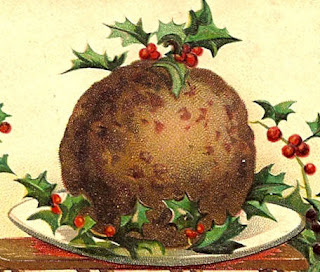 Some weeks before Christmas, Mimi chose a piece of flour sacking which she boiled until it was absolutely sterile. Once the batter and fruits were mixed, they were piled onto the cloth, then it was gathered up and tied at the top and steamed in a large boiler, the kind of copper boilers they did laundry in.
Some weeks before Christmas, Mimi chose a piece of flour sacking which she boiled until it was absolutely sterile. Once the batter and fruits were mixed, they were piled onto the cloth, then it was gathered up and tied at the top and steamed in a large boiler, the kind of copper boilers they did laundry in. What does affect the taste of the pudding (besides the ingredients) are the sauces — my Grandmother always served two, one warm, one room temperature — and the ceremonial flaming with warmed brandy in a darkened dining room, at which moment everyone oohed and aahed and Mimi said, “Well, it isn’t as good as last year’s.” We all disagreed, to her pleasure, year after year. If you try it, warm the brandy before pouring it over the pudding. If it is not warmed a bit, it won’t have the lovely blue flame you want.
What does affect the taste of the pudding (besides the ingredients) are the sauces — my Grandmother always served two, one warm, one room temperature — and the ceremonial flaming with warmed brandy in a darkened dining room, at which moment everyone oohed and aahed and Mimi said, “Well, it isn’t as good as last year’s.” We all disagreed, to her pleasure, year after year. If you try it, warm the brandy before pouring it over the pudding. If it is not warmed a bit, it won’t have the lovely blue flame you want. 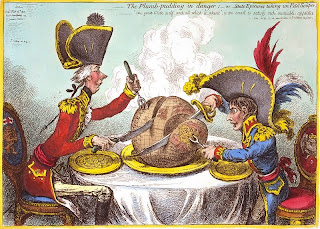 Plum pudding is a traditional dish and a traditional symbol of Britain. Here is a cartoon by James Gillray from 1805 called the Plum-pudding in Danger — showing the English possessing the sea while the French carve off Europe.
Plum pudding is a traditional dish and a traditional symbol of Britain. Here is a cartoon by James Gillray from 1805 called the Plum-pudding in Danger — showing the English possessing the sea while the French carve off Europe.Mimi’s Old English Plum Pudding
4 C. flour
1 C. butter or 3 scant C. suet, finely chopped
1 box currants, washed and dried well
1 box seedless raisins
1 box golden raisins
Optional: other dried fruits and nuts, such as candied orange or lemon peel, dried apricots, cherries, dates, chopped almonds, etc.
2 C. granulated sugar or brown sugar or one C. each
1 t. cinnamon
1 t ground ginger
Sprinkle of nutmeg
½ t. cloves (optional)
3-4 eggs
1 t baking soda
Milk by the spoonful
Sift flour, sugar and spices into large bowl. Add butter or suet, currants and raisins, and other fruits and nuts, as desired. Beat eggs and add to dry mixture, stirring well.
Add baking soda dissolved in a little hot water. Mix and stir to a stiff batter with milk. The mixture should be stiff enough that a wooden spoon will stand up in the batter.
Dip a pudding cloth (cotton flour sacking) in hot water, then dredge with flour. Add pudding mix and bring edges of cloth together and tie loosely (not real close to the pudding at the top).
Boil four hours in large kettle, placing the pudding into boiling water to cover. For round shape, tie top of cloth to a stick across the top of the pan.
OR: put pudding into a mold and steam according to directions for steamed puddings in any cookbook.
Note: Pudding should be served hot; may be prepared several days before serving and resteamed when served.
Place on platter and stick Holly in the top. Pierce with fork in several places. Warm brandy and pour over the pudding. Light and present to table with blue flames dancing on the surface of the pudding. Serve with warm lemon sauce and/or hard sauce. Keeps well in refrigerator if wrapped in foil.
Mimi’s Lemon Sauce for Plum Pudding
1 c. granulated sugar
2 T cornstarch
2 C boiling water
4 T butter
3-4 T Lemon Juice
¼ t. salt
Mix sugar and cornstarch, add water gradually, stirring constantly. Boil for 5 minutes. Remove from heat, add butter, lemon juice and salt. Serve warm over slices of plum pudding.
Mimi
’s Hard Sauce for Plum Pudding
1-2 C. powdered sugar
½ C. Butter
2 t. vanilla
Dash of rum or rum flavoring
Mix ingredients and beat until light and creamy. Refrigerate.
Happy Christmas!!
















